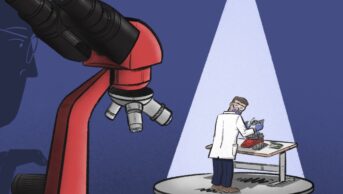
Source: Courtesy of Ross Ferguson and Martin Astbury
The issue of pharmacy supervision has been bubbling for over a decade, but it has returned to the news over the past couple of years since the Rebalancing Medicines Legislation and Pharmacy Regulation Programme Board was tasked with modernising legislation by the Department of Health and Social Care. The current requirement is stipulated in the Human Medicines Regulations 2012, which states that it is unlawful to sell or supply a medicine that is not subject to general sale, unless the sale or supply is made on registered pharmacy premises and the transaction is carried out by, or under the supervision of, a pharmacist[1]
.
Proposals were prepared by a working group of the rebalancing board, looking at how to allow a pharmacy professional — which could include a pharmacy technician — to supervise the sale and supply of pharmacy and prescription-only medicines[2]
. A consultation was also launched in June 2018 on removing the requirement for respÂonsible pharmacists to be in charge of only one pharmacy[3]
.
More fundamentally, there is confusion over what ‘supervision’ really means. The Human Medicines Regulations say it is the ‘transaction’ that has to be supervised, but some pharmacists think it means a pharmaÂcist has to carry out a clinical check; others think it means a final check before a medÂicine is handed out; while some say it is an accuracy check.
In advance of a major consultation on supervision, which is expected to be launched by the Royal Pharmaceutical Society in 2019, we asked two pharmacists to give their views on whether the existing legislation is fit for purpose and what, if any, changes they would like to see.
Yes: the current situation is unsustainable
Ross Ferguson, freelance pharmacy writer/editor, ex-pharmacy owner and former responsible pharmacist
When considering whether changes to supervision legislation would be useful, one has to look at what purpose they currently serve and what the benefits of any change would be.
It might be helpful to look at supervision as a spectrum, going from where we are now, to, at the other end, pharmacies without pharmacists. Few people are suggesting that this extreme would be a useful outcome. I am certainly not.
Where we are now, the pharmacy cannot operate when the pharmacist is not on the premises: sales of pharmacy medicines (P medicines) cannot be made; dispensed and checked prescriptions cannot be handed out to patients; and legally they can’t even be given to the pharmacy’s delivery driver.
I’m not convinced that what we are trying to protect is something we are actually doing
We’ve all been there — left for two minutes to grab a sandwich and to come back to a bench full of scripts to be checked or handed out, or a bewildered customer waiting to buy their medicine.
But what value do we currently provide when counter assistants hand out dispensed, checked and bagged repeat prescriptions? What percentage of people receiving them actually get advice or information?
And let’s not pretend that all P medicine sales are supervised by pharmacists. That is simply not true. The pharmacist may be on the premises, but it is impossible to be aware of every sale while also performing all the other tasks we do on a daily basis.
I’m not convinced that what we are trying to protect is something we are actually doing.
What is the difference between the pharmacist being in a consultation room with a patient when prescriptions are being handed out by counter assistants and them being handed out when the pharmacist is not on the premises? And, similarly, is the pharmacist aware of P medicine sales when they are in the consultation room, or using the toilet?
Now, the usual argument in both cases would be that the pharmacist has to be on the premises to intervene. Intervention is not possible if the pharmacist is busy elsewhere, but referral to the pharmacist is possible — some prescriptions will need to be given with some advice and the pharmacist will need to make sure some P medicine sales are appropriate, or that certain signs and symptoms are not indicative of a serious medical condition. Pharmacy technicians following standard operating procedures will know when to refer.
Where I’d like to be is in a world where community pharmacists provide similar services to GP pharmacists: helping people manage long-term conditions and prescribing for acute conditions — making a real difference to people and reducing the burden on GPs. But we cannot do that in a meaningful way on the shop floor, and if we’re spending a significant amount of time in a consultation room it certainly stretches the definition of supervision to breaking point.
So, in my view, if supervision is required then some of these roles can be undertaken by pharmacy technicians who would have to be accountable. Of course, there are issues here too — there aren’t enough pharmacy technicians and others will point to problems with training (such as that known as ‘grandparenting’).
As for remote supervision, allowing a pharmacist to be the responsible pharmacist for more than one pharmacy in extreme circumstances seems entirely sensible. Obviously, people are concerned that this means sliding down a slippery slope to a dark place that nobody wants to enter — that has to be avoided at all costs.
No: the rules are not a barrier to great care
Martin Astbury, community pharmacist and member of the English Pharmacy Board of the Royal Pharmaceutical Society
In today’s pharmacy, it is the pharmacist who is always on hand to make proactive and reactive interventions, whether intercepting a triple overdose on an infant’s prescription or intervening in the sale of an over-the-counter medicine to avoid possible hospitalisation of a patient. Each day, around 1.2 million visits are made to community pharmacies in England, which safely supply over a billion prescriptions each year. One in 550 of all prescription items prescribed by GPs in England are thought to be associated with an error, and pharmacists are estimated to query around 6.6 million prescription items per year— catching errors before they can cause serious harm to the patient.
If supervision legislation was watered down, it could be a short matter of time before some pharmacy owners move to a low-cost, low-quality model
But if we lower the bar of clinical intervention from that of a pharmacist to a pharmacy technician, we risk decreasing patient safety and eroding community pharmacy’s role in health care. And if supervision legislation was watered down to allow pharmacy technicians to supervise the sale and supply of medicines, it could be a short matter of time before some pharmacy owners move to a low-cost, low-quality model, resulting in pharmacies without pharmacists. Our standard of care would be reduced to the same level as that of some developing countries, in which — in my involvement with the International Pharmaceutical Federation — I have been helping to bring in legislation that cements pharmacist supervision and a higher standard of clinical intervention and patient care.
What we really need is to maximise the potential of pharmacy technicians in their vital technical role. We need to optimise the use of all pharmacy staff in the technical parts of the dispensing process: the ‘assembly stage’.
If we really want to make a difference with pharmacy technicians, it is time to formally recognise the important technical role that accuracy checking pharmacy technicians (ACPTs) can play. This would involve the General Pharmaceutical Council or the RPS holding a list of approved ACPTs. The pharmacist — working with ACPTs with legal and professional responsibility — would be assured in fully allocating the assembly process of dispensing. If pharmacists stop completing accuracy checks, we can free up the professional whose knowledge and clinical skills we really want to utilise. But the pharmacist must always be on the premises.
In an ideal world, medicines are sold and supplied safely in the community pharmacy, which is recognised as an NHS pharmacy walk-in centre. Pharmacists clinically check prescriptions. A pharmacist is always available to intervene or speak to patients when requested or required. A number of services and products are available. The pharmacy manages supply for the vulnerable. It offers a common ailments service. And through repeat dispensing, the pharmacist becomes the healthcare professional looking after stable patients for up to one year, without the patient needing to visit the GP during that time.
All of this is already possible under the existing legislation — it is insufficient staff levels and a lack of commissioning of services that are holding us back. Greater recognition of ACPTs would be beneficial, but the current supervision legislation is not a barrier to delivering great care.
- This a personal view and should not be seen as the policy position of the RPS.
References
[1] Department of Health. The Human Medicines Regulations 2012. 2012. Available at: http://www.legislation.gov.uk/uksi/2012/1916/contents/made (accessed December 2018)
[2] Torjesen I. Rebalancing Board chair acknowledges pharmacists’ ‘considerable fears’ around supervision. Pharm J 2017;299(7906):online. doi: 10.1211/PJ.2017.20203729
[3] Department of Health and Social Care. Pharmacy legislation on dispensing errors and organisational governance. 2018. Available at: https://www.gov.uk/government/consultations/pharmacy-legislation-on-dispensing-errors-and-organisational-governance (accessed December 2018)


